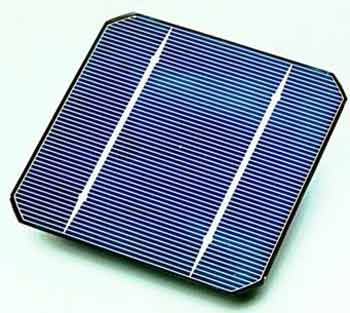|
The Solar Cell
The solar cell, or photovoltaic cell, forms the basis of a solar panel. It is the individual component in a solar module or solar panel. The cell converts sunlight directly into electricity by the photoelectric effect. Arrangements of cells are used to make solar panels, solar modules, or photovoltaic arrays.
Photovoltaics is a complex field of technology and research. It is related to the application of solar energy to produce electricity for practical use. History However, it was not until 1883 that the first cell was built by Charles Fritts. Fritts coated the semiconductor selenium with an extremely thin layer of gold to form the junctions. The device was only around 1% efficient. Sven Ason Berglund had a number of patents concerning methods of increasing the capacity of these cells. Russell Ohl patented the modern junction semiconductor cell in 1946, which was discovered while working on a series of advances that would lead to the transistor. The modern age of solar power technology arrived in 1954. Bell Laboratories - whilst experimenting with semiconductors - unexpectedly discovered that silicon doped with certain impurities became very sensitive to light. Daryl Chapin, Calvin Fuller and Gerald Pearson - all of Bell Labs - invented the first practical device for converting sunlight into useful electrical power. This lead to the production of the first practical solar cell with a sunlight conversion efficiency of around 6 percent. The first spacecraft to use solar panels was the US satellite Vanguard 1, launched in March 1958. This achievement stimulated production and launch of a geostationary communications satellite powered by solar energy. This was a crucial development which attracted funding from several governments into research for improved solar technologies. In 1970 the first highly effective cell was created by Zhores Alferov and his team in the USSR. In the United States, the first 17% efficient solar cells were manufactured in production quantities in 1988 by Applied Solar Energy Corporation (ASEC). In 1993, ASEC developed the first dual junction cells for spacecraft use in the United States, with a starting efficiency of approximately 20%. These cells used a cell with different doping. Eventually dual junction cells reached production efficiencies of about 22%. Triple Junction cells began with efficiencies of approximately 24% in 2000, 26% in 2002, 28% in 2005, and in 2007 had evolved to a 30% efficiency. Modern solar cells are classified into three generations based on the order of which each was developed. The first was Crystalline silicon and Vacuum deposition. Next came the thin-film cell and third generation is focused on improving second generation cells. All three generations are still being researched and improved today. The first generation technologies are favoured for commercial production, accounting for approximately 85% of production. Read more about the three generations of photovoltaic cells. How Do Solar Cells Work? Electrons release from their atoms, allowing them to flow through the cell material to produce electricity. Solar Cells And Energy Payback This raises the issue of energy payback, which is a very important consideration for ANY alternative energy source - after all, what is the point of harnessing alternate energy if it consumes more energy than it produces. Energy payback is the recovery period of the energy spent for manufacturing of the respective technical energy systems, also called harvesting ratio. In the 1990s - when silicon cells were twice as thick, cell lifetimes were shorter and efficiencies were 30% lower than today - it may well have cost more energy to make a cell than it could generate in a lifetime. Since then, the technology has progressed significantly, and the energy payback time of a modern photovoltaic module is typically from 1 to 4 years depending on the type and where it is used. Generally, thin film technologies - despite having comparatively low conversion efficiencies - achieve significantly shorter energy payback times than a conventional cell (often < 1 year). With a typical lifetime of 20 to 30 years, the modern solar cell is a net energy producer - i.e. it generates significantly more energy over a lifetime than the energy expended in producing it. Read more about the solar cell by choosing from the sub-topics below:
Return From Solar Cell to Home Page |






